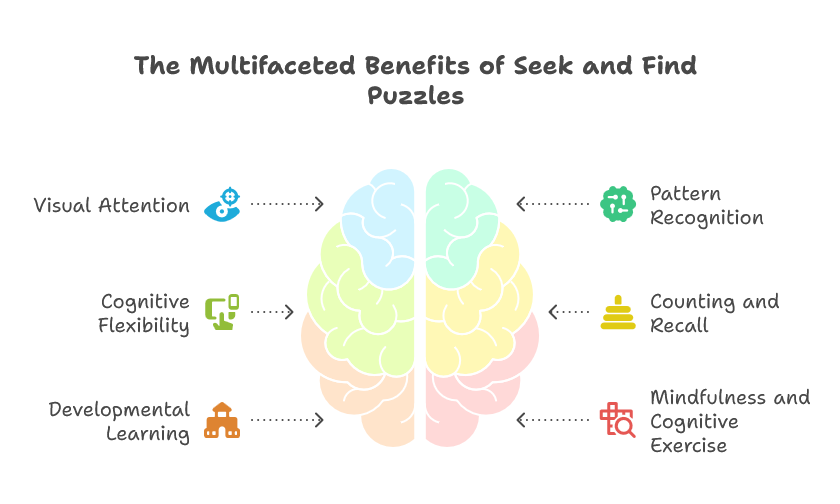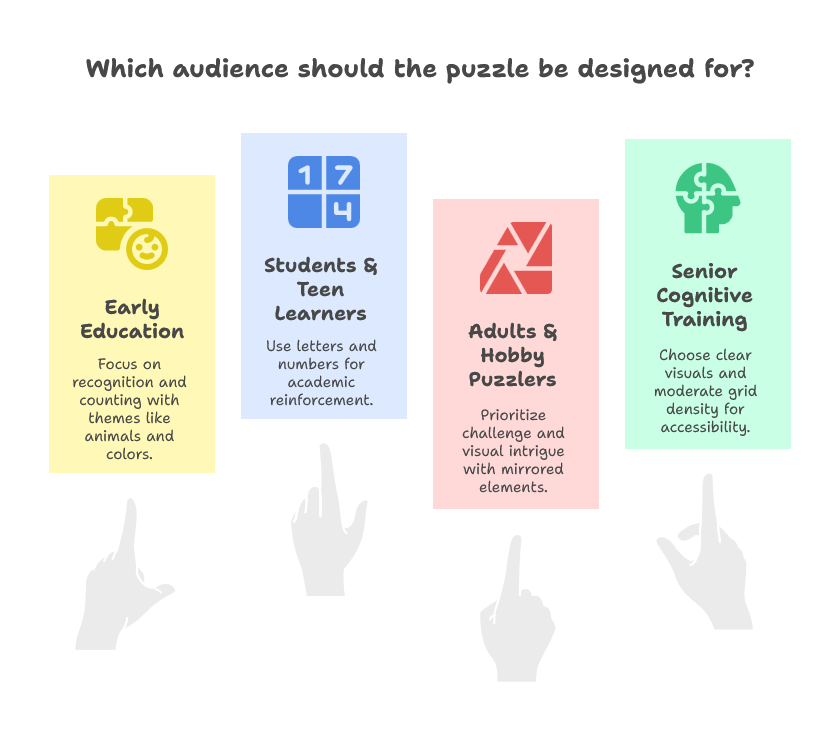Designing Seek and Find Puzzles for Every Age Group: From Preschool to Adults
How to design visually engaging puzzles for every skill level with Puzzle Maker Pro – Seek and Find
Introduction: One Puzzle Type, Endless Possibilities
What makes a puzzle irresistible to a five-year-old might frustrate an adult—and vice versa. The difference isn’t in the idea itself, but in how you design it.
Seek and Find puzzles tap into something universal: our natural curiosity to discover patterns, count, and recognize what stands out from the rest. They train focus, observation, and cognitive flexibility—skills valuable at every age. With Puzzle Maker Pro – Seek and Find, you can adapt the same puzzle concept for preschoolers, students, or seasoned puzzle enthusiasts with just a few setting changes.
Whether you want to create a classroom worksheet, an Etsy printable, or a puzzle book for adults, Seek and Find gives you the creative control to shape difficulty, style, and purpose—without needing to redraw or reformat everything from scratch.
Why Seek and Find Works for All Ages

Seek and Find puzzles engage the brain on multiple levels:
- Visual attention – spotting specific symbols or colors among decoys.
- Pattern recognition – understanding how small variations change meaning.
- Cognitive flexibility – adapting to visual or positional differences.
- Counting and recall – remembering what’s been found and what remains.
For young children, this translates into developmental learning. For adults, it becomes a form of mindfulness and cognitive exercise. The beauty of Seek and Find is that the same core puzzle mechanic can scale effortlessly from simple recognition to complex reasoning.
Choosing the Right Puzzle Type for Your Audience
In the current version of Seek and Find, each puzzle uses one content type:
- Images (e.g., animals, icons, themed artwork)
- Letters
- Numbers
- Colors (optionally with built-in shapes)
While each puzzle focuses on one type at a time, you can easily create themed sets using multiple versions—for example, one puzzle with letters, another with animals—to create variety within a single collection.
For Children
- Images and colors work best. Bright visuals and recognizable shapes help with engagement and memory.
- Use large grid cells and low fill density for easier visibility.
- Avoid rotations or mirroring at this level—young learners are still building recognition stability.
For Teens and Adults
- Letters and numbers add analytical complexity.
- Rotations and mirrored symbols make puzzles significantly harder.
- Smaller grids, higher fill densities, and minimal spacing increase challenge.
Tip: Because the puzzles are generated automatically, even when using the same settings, each output will vary due to randomization—making every puzzle unique.
Balancing Challenge and Accessibility
The balance between visual appeal and cognitive demand defines the puzzle’s success. Grid size and layout are central to this.

Puzzle Maker Pro’s auto grid sizing can select balanced layouts for you, or you can fine-tune the number of rows and columns manually for precise control—ideal when designing for print book templates or educational worksheets.
Pro tip: For classroom puzzles, keep the puzzle size manageable enough that students can complete it within one activity session (5–10 minutes). For KDP puzzle books, larger grids increase value and perceived challenge.
Fine-Tuning Difficulty with Visual Design
Seek and Find gives you direct control over the puzzle’s challenge level through its Advanced tab.
For Kids (Beginner Levels)
- No rotation or mirroring
- Use 30° or 45° rotation only for small difficulty increase
- Keep high symbol contrast and simple backgrounds
For Adults (Advanced Levels)
- Enable horizontal, vertical, or both mirroring
- Use rotation in 60° or 90° increments
- Increase fill density and add decoy symbols (noise) for cluttered visuals
This ability to manipulate perception makes Seek and Find puzzles flexible for visual training, memory, and even mindfulness exercises.
Matching Puzzle Goals to Your Audience

Each audience approaches puzzles differently, and your design choices should reflect their goals.
Early Education (Preschool & Early Elementary)
- Focus on recognition and counting.
- Themes like animals, fruits, or colors encourage association.
- Add legend counts (e.g., “Find 5 apples, 3 oranges”).
- Educational use: color identification, number awareness, and pattern discovery.
Students & Teen Learners
- Use letters and numbers to support academic reinforcement.
- Great for letter recognition, spelling warm-ups, or math review activities.
- Example: “Find all the letter Gs rotated sideways” to train attention to detail.
Adults and Hobby Puzzlers
- Prioritize challenge and visual intrigue.
- Use mirrored letters or upside-down numbers to disrupt recognition and keep engagement high.
- Ideal for puzzle books, magazine inserts, and mindfulness-themed products.
Senior Cognitive Training
- Choose clear, high-contrast visuals and moderate grid density.
- Avoid excessive mirroring to maintain accessibility.
- Focus on attention, focus, and visual recall—key exercises for cognitive health.
Style, Branding, and Presentation
Each Seek and Find puzzle can reflect your unique brand or creative theme. Use the Style and Branding tabs to:
- Adjust symbol size and spacing for layout consistency.
- Add your logo or website as a watermark.
- Customize title, description, and header colors to match your puzzle book or classroom branding.
The Instant Puzzle Books feature (included in both versions) lets you export ready-to-print pages. Each puzzle automatically includes both puzzle and solution files—saving hours of manual formatting.
Practical Use Cases Across Audiences
For Educators (Preschool to Grade 8)
- Morning warm-up activities or station work.
- Reinforcement for letters, numbers, or colors.
- Homework sheets with visual variation.
For Publishers and Etsy Sellers
- Build themed Seek and Find collections: holiday packs, animals, travel, seasons.
- Mix easy and hard puzzles to widen your target audience.
- Offer “Find & Count” worksheets as printable downloads.
For Puzzle Enthusiasts and KDP Creators
- Create books combining Seek and Find with other puzzle types.
- Offer difficulty tiers for progression-based puzzle books.
- Add thematic challenges (e.g., mirrored numbers only, rotated letters only).
Example CTA inside content:
“Want to design Seek and Find puzzles for kids, classrooms, or puzzle book collections?
Try Puzzle Maker Pro – Seek and Find and build your first puzzle today.”
Balancing Visual Appeal and User Experience
The art of Seek and Find puzzles is not just complexity—it’s clarity. A good puzzle challenges without overwhelming. To ensure a great experience for all users:
- Keep sufficient contrast between foreground and background.
- Use consistent symbol spacing (especially in color-based puzzles).
- Test readability by printing a sample grid.
- For children, ensure all symbols are distinct and visually friendly.
If you’re creating puzzles for commercial publication, visual polish directly affects sales and customer reviews. With the built-in preview tools, you can adjust settings until every puzzle feels professional and consistent.
Structuring Puzzle Collections by Skill Level
When building puzzle books or printable series, structure them to reflect progression:
| Section | Focus | Difficulty Example |
|---|---|---|
| Easy | Animal or color puzzles | Large grid, no rotation |
| Medium | Letters or numbers | Moderate fill, light rotation |
| Hard | Mirrored/rotated letters & numbers | Dense grid, noise decoys |
This tiered structure works for both educational materials and commercial puzzle books, encouraging engagement and replay value.
Exporting and Publishing Made Simple
Once you’ve refined your designs:
- Click Create to generate the puzzle and solution pair.
- Choose your preferred format (JPG, PNG, PDF).
- Import into your preferred layout tool (PowerPoint, Word, InDesign) or use Instant Puzzle Books for automatic page generation.
All exports are print-ready, allowing educators to distribute worksheets immediately and publishers to compile professional puzzle books with minimal editing.
Conclusion: One Puzzle Concept, Infinite Creations
Seek and Find puzzles adapt effortlessly to any skill level, making them one of the most versatile puzzle formats available today. From preschool classrooms to adult brain-training books, the design options are nearly limitless.
By adjusting a few key parameters—content type, grid size, and visual difficulty—you can create puzzles that challenge and delight any audience. And with Puzzle Maker Pro, you can do it all in minutes.
Ready to get started?
Explore Puzzle Maker Pro – Seek and Find and design your first Seek and Find puzzle for any age group today.
Here’s a clean, ready-to-use Further Reading block you can paste at the end of Article 1 – “Designing Seek and Find Puzzles for Every Age Group.”
It follows your internal link structure and SEO hierarchy — educational first, commercial second — and encourages readers to keep exploring related content.
🧭 Further Reading
If you enjoyed this guide, you might also like these related articles:
- Beyond Word Searches: Adding Visual Puzzles to Your KDP and Etsy Books
- How Seek and Find Puzzles Boost Visual Learning in Kids
- The Psychology Behind Seek and Find: Why Our Brains Love Visual Challenges
- Building a Visual Puzzle Brand for KDP
- How to Build a Complete Puzzle Book Using Seek and Find Themes
